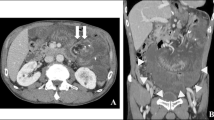Abstract
Bariatric surgery plays an important role in weight management in current medical practice. Bypass procedures involve alternating the anatomic structure of alimentary tract to achieve malabsorption, which in turn leads to weight loss. Despite its low incidence, internal hernia can occur when an iatrogenic mesenteric defect is created during bariatric surgery. We herein report a video case of laparoscopic management of a complicated internal hernia after proximal jejunal bypass surgery. The patient was a 23-year-old woman who had undergone her first bariatric surgery of laparoscopic proximal jejunal bypass with gastric clipping 5 years earlier and revisional sleeve gastrectomy (SG) for weight regain 10 months prior to this admission. She presented to our emergency department with a complaint of intermittent cramping abdominal pain for the last 2 weeks. Physical examination revealed diffuse tenderness with mild muscle guarding. Computed tomography revealed a swollen and dilated segment of small bowel and some ascites in the pelvic region. Diagnostic laparoscopy was performed after confirming that a segment of the jejunum, adjacent to the previous jejuno-jejunal anastomosis (JJA), had herniated into the mesojejunal region. Subsequently, laparoscopic reduction of the twisted jejunum and resection of the ischemic segment of the biliopancreatic limb were performed. Redo JJA was performed and the mesenteric defect was closed with a running barbed suture. The postoperative course was uneventful, and the patient was discharged 8 days after surgery.
Similar content being viewed by others
References
Huang C-K, Mahendra R, Hsin M-C et al (2016) Novel metabolic surgery: first Asia series and short-term results of laparoscopic proximal jejunal bypass with sleeve gastrectomy. Ann Laparosc Endosc Surg 1
Sepúlveda M, Alamo M, Preiss Y et al (2018) Metabolic surgery comparing sleeve gastrectomy with jejunal bypass and Roux-en-Y gastric bypass in type 2 diabetic patients after 3 years. Obes Surg 28(11):3466–3473
Ma IT, Madura JA (2015) Gastrointestinal complications after bariatric surgery. Gastroenterol Hepatol 11(8):526
Marchini AK, Denys A, Paroz A et al (2011) The four different types of internal hernia occurring after laparascopic Roux-en-Y gastric bypass performed for morbid obesity: are there any multidetector computed tomography (MDCT) features permitting their distinction? Obes Surg 21(4):506–516
Lin S, Li C, Guan W et al (2021) Three-Year outcomes of sleeve gastrectomy plus jejunojejunal bypass: a retrospective case-matched study with sleeve gastrectomy and gastric bypass in Chinese patients with BMI≥ 35 kg/m2. Obes Surg 1–6
Sewefy AM, Saleh A. The outcomes of single anastomosis sleeve jejunal bypass as a treatment for morbid obesity (Two-year follow-up). Surg Endosc. 2020;1–7.
Sepúlveda M, Alamo M, Astorga C et al (2021) Histologic and microbiological findings of the defunctionalized loop in sleeve gastrectomy with jejunal bypass. Surg Obes Relat Dis 17(1):131–138
Rodriguez A, Mosti M, Sierra M et al (2010) Small bowel obstruction after antecolic and antegastric laparoscopic Roux-en-Y gastric bypass: could the incidence be reduced? Obes Surg 20(10):1380–1384
Geubbels N, Lijftogt N, Fiocco M et al (2015) Meta-analysis of internal herniation after gastric bypass surgery. Br J Surg 102(5):451–460
Author information
Authors and Affiliations
Corresponding author
Ethics declarations
Ethical Approval
All procedures performed in studies involving human participants were in accordance with the ethical standards of the institutional and/or national research committee and with the 1964 Helsinki declaration and its later amendments or comparable ethical standards.
Informed Consent
Informed consent was obtained from all individual participants included in the study.
Conflict of Interest
The authors declare no competing interests.
Additional information
Publisher's Note
Springer Nature remains neutral with regard to jurisdictional claims in published maps and institutional affiliations.
Key Points
1. Bariatric surgery is frequently performed nowadays. Additional proximal jejunal bypass with a restrictive procedure has shown promising results.
2. Internal herniation occasionally occurs due to mesenteric defects that are created during the bariatric bypass procedure.
3. We report a video case of laparoscopic management for internal hernia after proximal jejunal bypass.
Supplementary Information
Below is the link to the electronic supplementary material.
Supplementary file1 (MP4 136343 KB)
Rights and permissions
About this article
Cite this article
Feng, TY., Pan, HM., Lin, CH. et al. Laparoscopic Management of Complicated Internal Hernia After Proximal Jejunal Bypass (Video Report). Indian J Surg (2022). https://doi.org/10.1007/s12262-021-03248-5
Received:
Accepted:
Published:
DOI: https://doi.org/10.1007/s12262-021-03248-5



